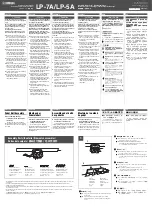
On channels 1-32 you can program a different MIDI channel and MIDI controller
number for the fader, mute key and pan knob. On the master layer you can do
this for faders and mutes only. This allows the DM-24 to control other devices or
other devices to control the DM-24 via MIDI. Again, this uses the “audio faders.”
There is also an external control page on the DM-24. This is where you can set
up separate MIDI fader layers and controller pages. Any combination of fader
layers and controller pages can used up to a total of 8.
With the MIDI fader layer, fader 1 is MIDI channel 1, fader 2 is MIDI channel 2,
etc. A single controller number is selected for ALL faders. You can have up to 8
MIDI fader layers. Each layer would represent a different MIDI controller
number.
With the controller page you have access to 19 of the most common controller
numbers. These are accessed using the POD knobs and Data wheel. Each of
these controller pages represents one MIDI channel. You can use a total of 8
controller pages which would give you access to 8 different MIDI channels.
CASCADING TWO DM-24s
Two DM-24s can be cascaded together to act as one large console. This
requires a cascade option card in each mixer. Cascading allows the two mixers
to share busses 1-8, aux sends 1-6, the solo buss and the stereo buss.
Connections to the control room and stereo outputs would be made on the
cascade master.
Cascading two DM-24s provides access to 4 internal effects processors (2 in
each unit). When the aux sends are cascaded, ANY of the four internal effects
processors can be accessed from ANY aux send. The DM-24 represents the
state of the art in effects routing for digital mixing consoles.
Mutes and Solos also act as if two cascaded DM-24s are just one big console.
PFL, AFL or INPLACE settings are made on the cascade master. INPLACE solo
defeats can be assigned to ANY channel on the cascade master and slave.
Because busses 1-8 can be shared, 5.1 surround mixing is possible with two
cascaded DM-24s. An AES/EBU option card could be added to the cascade
master for sending the 5.1 mix digitally to the stem recorder and an analog option
card could be added to the cascade slave to send the 5.1 mix to the surround
monitoring system. Cascading also works at 96kHz!
When a mix snapshot is stored on the master, a mix snapshot is also stored on
the slave simultaneously. The same is true for saving automation mixes.
However, when these files need to be cleared from the DM-24 to make room for
new mixes, these files would have to be transferred individually from each DM-24
to an external MIDI device for storage.
The stereo buss, control room and studio outputs on the cascade slave can be
used independently of the cascade master. This allows many benefits. For
instance, the stereo buss on the cascade master could be output dry while a
compressor could be inserted on the stereo buss of the cascade slave. With 2
AES/EBU, S/PDIF and balanced analog outputs, up to 6 stereo mixes could be






























